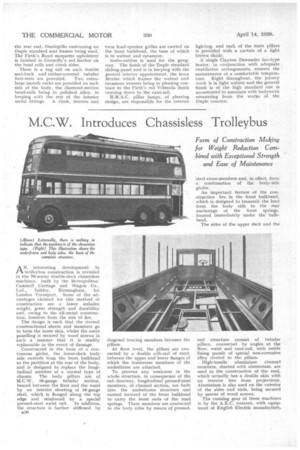M.C.W. Introduces Chassisless Trolleybus
Page 46

If you've noticed an error in this article please click here to report it so we can fix it.
Form of Construction Making for Weight Reduction Combined with Exceptional Strength and Ease of Maintenance
A N, interesting development in
trolleybus construction is revealed in the 70-seater double-deck chassisless machines, built by the MetropolitanCam/dell Carriage and Wagon Co., Ltd., Saltley, Birmingham, for London Transport. Some of the advantages claimed for this method of construction are a lower unladen weight, great strength and durability and, owing to the all-metal construction, freedom from the risk of fire.
The design is such that the riveted constructional sheets and members go to form the inner skin, whilst the outer panelling is secured by wood screws in such a manner that it is readily replaceable in the event of damage.
Constructed in the form of a continuous girder, the lower-deck body side extends from the front bulkhead to the partition at the rear of the body, and is designed to replace the longitudinal member of a normal type of chassis. The body pillars are of 16-gauge tubular section, braced between the floor and the waist by an interior sheeting of 16-gauge steel, which is flanged along the top edge and reinforced by a special pressed-steel waist rail. tn addition, the structure is further stiffened by e3t; diagonal bracing members between the pillars.
At floor level, the pillars are connected by a double crib-rail of steel, between the upper and lower flanges of which the transverse members of the underframe are attached.
To prevent any weakness in the whole structure, in consequence of the cab doorway, longitudinal pressed-steel members, of channel section, are built into the underframe structure and extend forward of the front bulkhead to carry the front ends of the road springs. These members are connected to the body sides by means of pressed
steel cross-members and, in effect, form a continuation of the body-side girder.
An important feature of the construction lies in the front bulkhead, which is designed to transmit the load from the body side to the rear anchorage of the front springs, located immediately under the bulkhead.
The sides of the upper deck and the end structure consist of tubular pillars, connected by angles at the floor, waist and cant-rail, with inside lining panels of special non-corrosive alloy riveted to the pillars.
High-tensile aluminium channel members, sheeted with aluminium, are used in the construction of the roof, which actually has a double skin with an interior free from projections. Aluminium is also used on the exterior of the sides and ends, being secured by means of wood screws. The running gear of these machines is by the A.E.C. concern, with equipment of English Electric manufacture.




















































































